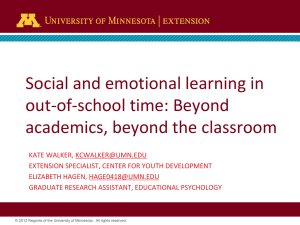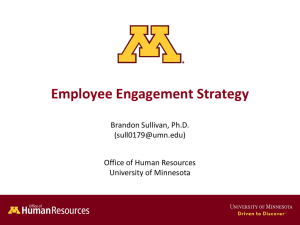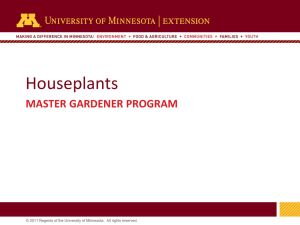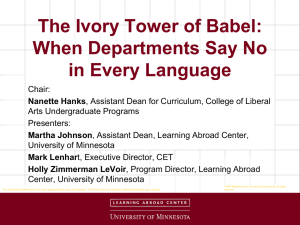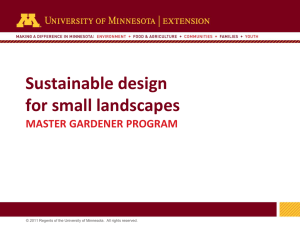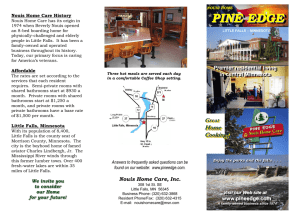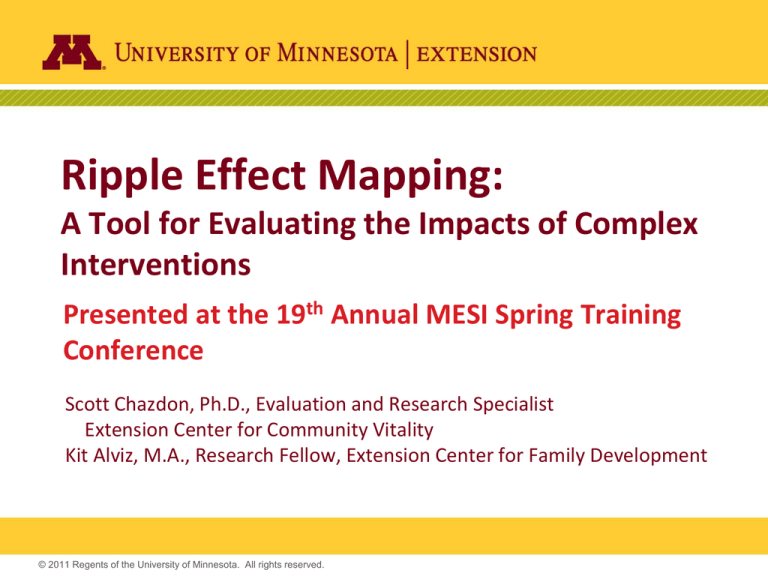
Ripple Effect Mapping:
A Tool for Evaluating the Impacts of Complex
Interventions
Presented at the 19th Annual MESI Spring Training
Conference
Scott Chazdon, Ph.D., Evaluation and Research Specialist
Extension Center for Community Vitality
Kit Alviz, M.A., Research Fellow, Extension Center for Family Development
© 2011 Regents of the University of Minnesota. All rights reserved.
Session Overview
Background – 20 minutes
Demonstration – 40 minutes
Want to try mind mapping? Download from www.xmind.net
Discussion – 45 minutes
© 2011 Regents of the University of Minnesota. All rights reserved.
Session Learning Objectives
Describe the elements of the Ripple Effect Mapping
process.
Identify the skills needed to facilitate a Ripple Effect
Mapping session.
Give examples of the types of situations in which Ripple
Effect Mapping would make sense.
Produce the first stage of a Ripple Effect mind map
(optional).
Weigh the benefits and limitations of Ripple Effect
Mapping as an evaluation tool.
© 2011 Regents of the University of Minnesota. All rights reserved.
Ripple Effect Mapping
Purpose – to better understand intended
and unintended results of a program,
intervention or collaborative for individuals,
groups, sectors or communities.
Can be post-program (more summative) or
mid-program (more developmental)
© 2011 Regents of the University of Minnesota. All rights reserved.
Direct vs. Indirect Impacts
Collaboratives and high engagement
programs often build social capital, but
don’t take credit for it.
People do not act in isolation -strengthened social capital is a necessary
pre-condition for other impacts
Other impacts may occur that were not
foreseen in program theory
© 2011 Regents of the University of Minnesota. All rights reserved.
Mind Mapping – Radiant Thinking
Pictorial Method
– Note taking
– Brainstorming
– Organizing
– Problem
solving
– Evaluation
For more on mind mapping, see Buzan, T. (2003). The mind map book. London: BBC Books.
Image: Mindmap, Graham Burnett,
http://en.wikipedia.org/wiki/File:Mindmap.gif
Ripple effect mapping:
related approaches
Concept Mapping (Trochim, 1989)
Mind Mapping (Eppler, 2006)
Outcome Mapping (Outcome Mapping Learning Community, 2011)
Participatory Impact Pathway Analysis
(Douthwaite et al, 2008)
Most Significant Change (Davies 2005)
Appreciative Inquiry
© 2011 Regents of the University of Minnesota. All rights reserved.
(Preskill & Catsambas, 2006)
How Does it Work?
Identify the intervention
Schedule the event and invite
participants
Group mapping session held
Follow-up interviews
Cleaning, Coding, Analysis
© 2011 Regents of the University of Minnesota. All rights reserved.
RIPPLE EFFECT MAPPING
Method
– Identify the intervention
High engagement program or position
Cross-sector initiative
Collaboration
– Invite stakeholder group
Participants
Non-participant stakeholders
12 to 20 participants
Two moderators
© 2011 Regents of the University of Minnesota. All rights reserved.
RIPPLE EFFECT MAPPING
Method
– Appreciative Inquiry interview
Conducted among pairs of participants
Examples of questions:
– Tell me a story about how you have used the information from the
program?
– Is there anything that resulting from the program that you are
proud to share?
– List an achievement or a success you had based on what you
learned.
© 2011 Regents of the University of Minnesota. All rights reserved.
RIPPLE EFFECT MAPPING
Method
– Starting the Map
On wall or using Mind Mapping software with data
projector
Floating topics generated from Appreciative Inquiry
– Different approaches
© 2011 Regents of the University of Minnesota. All rights reserved.
THEMING AND RIPPLING
- Building the Map
Theming
- Group identifies which items are closely related
- Group generates initial theme names
- Floating topics moved and organized
Rippling
- Group cross-validation
- Potential for probing using the Community Capitals
Framework
© 2011 Regents of the University of Minnesota. All rights reserved.
RIPPLE EFFECT MAPPING
Examples of Contexts where REM
makes sense
Kit: State systems building to improve quality
and quantity of child care
Scott: Community leadership development
© 2011 Regents of the University of Minnesota. All rights reserved.
RIPPLE EFFECT MAPPING
Demonstration of Mapping Process
Think back to your first program evaluation
experience.
– Is there anything that you gained from this experience that you
are proud to share?
– List an achievement or a success you had based on what you
learned or who you met.
– Did the experience lead to other important developments in your
personal or professional life?
Floating topics
Beginning to categorize
© 2011 Regents of the University of Minnesota. All rights reserved.
Example: Ripple Effect Map of Community Gardening
in Frogtown & Rondo neighborhoods
Example: Ripple Effect Map of Community Gardening
in Frogtown & Rondo neighborhoods
Example: Ripple Effect Map of Hugo, MN
Business Retention and Expansion program
© 2011 Regents of the University of Minnesota. All rights reserved.
Example: Ripple Effect Map of Child Care
Expansion Initiative
© 2011 Regents of the University of Minnesota. All rights reserved.
RIPPLE EFFECT MAPPING
Cleaning, Coding, Analysis
– Organize map to better identify pathways or
combine pathways
– Download data to Excel for coding
– Code using relevant thematic framework and
type of outcome
KASA = something learned
Behavior change = action taken
Impact = change in system
– Follow-up interviews if more clarity is needed
© 2011 Regents of the University of Minnesota. All rights reserved.
The Community Capitals Framework
(Emery and Flora, 2008)
RIPPLE EFFECT MAPPING
Coding Demonstration
© 2011 Regents of the University of Minnesota. All rights reserved.
Coding Example
First
order Second
(core
order
outputs) ripples
Third
order
Fourth
order
Human capital
effects
(knowledge
and behavior Social capital
change)
effects
Civic effects
Financial
effects
X
X
Built capital
effects
Health, Food
and Nutrition
Effects
Cultural
effects
Natural
environment
effects
Market the City of Hugo
City identity workshop -
How to attract residents
and biz (coninuing work)
Have identified key attributes about
the City
X
X
X
X
X
Create, Coordinate, and Encourage Events
New position at City for park & rec.
planning
X
X
~10 new recreation
programs
X
X
Hanifl Fields attracted
over 20,000 kids
X
X
Entrepreneurial Bootcamp
X
Businesses have used City resources
Provide promotion opps. for biz
Coupons at football
tourney
X
X
X
?
X
X
X
?
Reporting Example (Hugo BR&E program)
Category of
Community
Program Effects
Human capital
effects (knowledge
and behavior
change)
Social capital
effects
Civic effects (aka
Political)
Financial effects
Built capital effects
Count of
reported effects Percent of
(out of a total of 41 reported
Definitions of Categories effects reported)
effects
Changes in knowledge,
attitudes, or skills among
25
61.0%
community members.
Strengthened or expanded
connections among people,
groups and organizations.
Increased ability of
communities to access and
mobilize public resources.
Increased private and public
wealth that is invested in the
well-being of communities.
Improvement of structures
and infrastructures that
contribute to the well-being of
communities.
12
29.3%
20
48.8%
11
26.8%
7
17.1%
Examples
1. Increased awareness of how many and
what kind of businesses are in the
community 2. City staffers got to know
businesses
1. Hugo Business Association is gathering
more often with a purpose. 2. City and
business groups are interacting more.
1. Created and filled a park & recreation
planning position 2. City is still using a biz
resource guide that was created in the
BR&E program to assist businesses.
1. Xcel Energy creating a training center
with 10 jobs and lots of visiting trainees. 2.
Provide promotion opps. for biz 3. City
actively recruiting events to be held in Hugo
Removed blighted buildings using 10 year,
interest free loans with businesses.
Reporting Example (Child Care Expansion)
Appendix – Ripple Effect Tables
Ripples for Theme 1: Updating regulations
Individuals volunteer their time and
energy to Health and Safety
Regulations Work Group
No funding
This is their passion; many have been
working in the trenches for over 30
years
Passion to make child care settings as
safe as possible
Prevention and keeping parents
aware
Grounded in the reality of day to
day
Children that fell through the cracks- reason for
being here
White papers, living document that
can be used daily
Completed and submitted Safe Sleep
Paper to Dept. of Social Services
Community Care Licensing
Parent group member presented
the paper
Within one month, the Licensing Division
responded and said they would start moving on
the changes
Babies will be
safer when they
sleep
Benefits
Simple and cheap tool
Captures impacts of complex or evolving
work
Captures intended and unintended
impacts
Participatory and appreciative approach
that engages stakeholders
Group validation of results
© 2011 Regents of the University of Minnesota. All rights reserved.
Limitations
Risk of bias in participant selection and
data collection
Participants may not have complete
information about a program or program
outcomes
Potential for inconsistency in
implementation
© 2011 Regents of the University of Minnesota. All rights reserved.
Suggestions
Use same facilitator, recorder and “mapper”
Develop a facilitator guide with ideas for probes.
Make decision prior to mapping whether to use a
pre-existing framework as probes during group
interviews
May need to recognize that one organization
isn’t trying to take all credit for all change
It is important to probe for negatives
© 2011 Regents of the University of Minnesota. All rights reserved.
Lessons Learned Thus Far
Find the right balance between breadth and
depth
Schedule the event along with another activity
Put much effort into recruitment and explaining
the process
Choose a good setting – not too informal
Use external facilitators, not program staff
© 2011 Regents of the University of Minnesota. All rights reserved.
Q&A and Discussion
© 2011 Regents of the University of Minnesota. All rights reserved.
References
Baker, B., Calvert, M., Emery, M., Enfield, R., & Williams, B. (2011). Mapping the impact of youth on
community development: What are we learning? [PowerPoint slides]. Retrieved from
http://ncrcrd.msu.edu/uploads/files/133/Mapping%20Impact%20of%20Youth%20on%20Com%20Dev%2
012-3-10.pdf
Buzan, T. (2003) The Mind Map Book. London: BBC Books.
Douthwaite, B., Alvarez, S., Thiele, G., & MacKay, R. (2008). Participatory impact pathways analysis: A
practical method for project planning and evaluation. ILAC Brief 17.
Emery, M., & Flora, C.B. (2006). Spiraling-up: Mapping community transformation with community
capitals framework. Community Development: Journal of the Community Development Society 37(1), 1935.
Eppler, M.J. (2006). A Comparison Between Concept Maps, Mind Maps, Conceptual Diagrams, and
Visual Metaphors as Complementary Tools for Knowledge Construction and Sharing. Information
Visualization 5:202-210.
Hansen Kollock, D.A., Flage, L, Chazdon, S., Paine, N., and Higgins, L. (2012). Ripple Effect Mapping:
A “Radiant” Way to Capture Program Impacts. http://www.joe.org/joe/2012october/tt6.php
Kollock, D. A. (2011). Ripple effects mapping for evaluation. Washington State University curriculum.
Pullman, WA.
Outcome Mapping Learning Community website. (2011). http://www.outcomemapping.ca
Preskill, H. & Catsambas, T.T. (2006). Reframing evaluation through appreciative inquiry. Thousand
Oaks: Sage Publications.
© 2011 Regents of the University of Minnesota. All rights reserved.
Contact information
Scott Chazdon, Ph.D.
Evaluation and Research Specialist
Center for Community Vitality
612-624-0982
schazdon@umn.edu
Kit Alviz, M.A.
Research Fellow
Center for Family Development
612-625-8271
alviz002@umn.edu
© 2011 Regents of the University of Minnesota. All rights reserved.
Thank you!
© 2011 Regents of the University of Minnesota. All rights reserved.
The University of Minnesota is an equal opportunity educator and employer. This PowerPoint is available in alternative formats
upon request. Direct requests to 612-625-8233.


